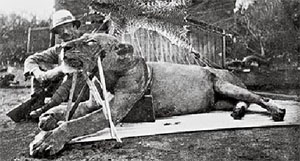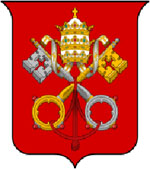The Hidden God
Lieutenant Colonel John Patterson had a job to do. The race to complete the Uganda-Mombasa Railway was well underway. John's job was to build a bridge over the Tsavo River. As a man who enjoyed big game hunting, John was looking forward to possibly bagging some trophies while being stationed there. As he surveyed his new home that pleasant March evening in 1898, little did he know that nearby was a sinister presence, an evil intelligence, lurking in the gathering darkness.
A few days after his arrival, two of his best workers disappeared. They were but the first of many. Three weeks later, John was awakened to the news that one of his Indian officers, Ungan Singh, had been killed. During the night a lion was seen thrusting its head through the doorway of Singh's tent. Grabbing Singh by the neck, the lion had dragged him off and eaten him. John quickly set about to hunt down the beast, for once a lion has a taste for human blood, it becomes insatiable. However, everything he tried, failed. More and more men were dragged screaming from their tents at night to become meals for a lion.
To the horror of all, it quickly became apparent that there were not one, but two lions working in cooperation! For nine long months, these lions were a constant menace to all working on the railroad. As time passed, the lions grew bolder.1 The Indian coolies began to fear that these were not animals at all, but demons. Indeed, their uncanny ability to avoid ambushes and traps, soundlessly penetrate thick barriers, ignore live animals and refuse poisoned bait left for them, lent support to the idea.2
At first they [the lions] were not always successful in their efforts to carry off a victim, but as time went on they stopped at nothing and indeed braved any danger in order to obtain their favourite food. Their methods then became so uncanny, and their man-stalking so well-timed and so certain of success, that the workmen firmly believed that they were not real animals at all, but devils in lions' shape . . . They almost appeared, too, to have an extraordinary and uncanny faculty of finding out our plans beforehand, so that no matter in how likely or how tempting a spot we lay in wait for them, they invariably avoided that particular place and seized their victim for the night from some other camp. . . nothing flurried or frightened them in the least, and except as food they showed a complete contempt for human beings. Having once marked down a victim, they would allow nothing to deter them from securing him, whether he were protected by a thick fence, or inside a closed tent, or sitting round a brightly burning fire. Shots, shouting and firebrands they alike held in derision.3
The lions became so bold that they quit dragging their victims away, eating them within earshot of the survivors. This reign of terror finally culminated in December when work on the railroad was brought to a standstill for three weeks.
 |
| One of the man-eaters of Tsavo. |
One experienced big game hunter hired to kill the lions was himself killed by animals that had lost all fear of humans. Finally, after nearly losing his own life in the process, John Patterson killed the first man-eater. "The prize was indeed one to be proud of; his length from tip of nose to tip of tail was nine feet eight inches, he stood three feet nine inches high, and it took eight men to carry him back to camp."4 A few weeks later, the second lion was killed. "He measured nine feet six inches from tip of nose to tip of tail, and stood three feet eleven and a half inches high."5 Thus ended a nightmare of violence which claimed the lives of no less than 35 people.6
There is something inherently terrifying about a sinister presence, strong, intelligent and evil, lurking just on the edges of your vision. You cannot get a good look at it, but you know that it is there: a fleeting glimpse, a mere impression, a sense that you are in danger. Such was the experience of the railroad builders who encountered the Tsavo man-eaters. One can only imagine the intensity of emotion and stress, knowing that such evil prowled nearby, intelligently, patiently waiting for an opportunity to kill again.
But for the sake of illustration, let us add a spin to the facts. Suppose Lt. Colonel Patterson, in a desperate attempt to find the man-eaters and protect his men, contacted a local native known for his trained lions: lions that had been trained to hunt down and kill other lions. Suppose Patterson hired the native to bring his tame, well-trained lions to camp. After initial surprise and unease, the workers start to relax when they see how gentle and friendly the pet lions are. The workers befriend their lion-guardians: petting them, slipping them food at meal time, accepting them as an important part of camp life. The tame lions do not have the hoped-for success in tracking down the wild man-eaters, but they do appear to frighten the wild lions away.
However, after a few weeks of peace, the man-eaters strike again, and yet again and still again; always with an uncanny awareness of where the traps are set. The horrifying realization finally dawns that it is their animal friends, the "well-trained, gentle" lions who are actually responsible for the grisly deaths of the workers. In focusing on the danger, they had actually brought the deadly menace directly into camp.
At what point were the railroad men most in danger? When they were living on the knife's edge of tension, huddled in tents, shivering behind barricades, knowing there were evil man-eaters stalking into camp? Or when they welcomed the man-eaters into camp, accepted them as safe, petted and fed them, all the while not knowing that it was the man-eaters themselves around whom they were relaxing their guard? This is not mere idle speculation. Rather this has already occurred on such a huge scale, no one has ever seen far enough, or studied deep enough to recognize it.
The Baylonian lions openly stalking the camp of Christendom have been the lions of Sunday worship. Saturday Sabbatarians, convicted by conscience to worship on the seventh-day of the week, have been outward focused; and there is danger in believing that any person, pope or otherwise, has the power to change the eternal law of the one true Eloah. It is good for the danger of this lie to be exposed. However, there is a far greater danger. It is more sinister, more effective because it not recognized as a danger. It is hidden in plain sight. The "pet lions" who have been accepted as safe are Saturday, the very heart of the babylonian mysteries.
Like the workers on the Uganda-Mombasa Railway in the altered story who focused on the lions outside, all the while ignoring the danger of the "tame" lions in their midst, the god of Saturday has been hidden. When Nimrod/Saturn was slain for idolatry, it profoundly shocked all who had revered him for his prodigious strength. That a colossus such as he could be killed, and in so gruesome a manner, drove idolatry into hiding.7
Now when Shem had so powerfully wrought upon the minds of men as to induce them to make a terrible example of the great Apostate, and when that Apostate's dismembered limbs were sent to the chief cities, where no doubt his system had been established, it will be readily perceived that, in these circumstances, if idolatry was to continue – if, above all, it was to take a step in advance, it was indispensable that it should operate in secret. The terror of an execution, inflicted on one so mighty as Nimrod, made it needful that, for some time to come at least, the extreme of caution should be used. In these circumstances, then, began, . . . that system of "Mystery," which, having Babylon for its centre, has spread over the world. In these Mysteries, under the seal of secrecy and the sanction of an oath, and by means of all the fertile resources of magic, men were gradually led back to all the idolatry that had been publicly suppressed, while new features were added to that idolatry that made it still more blasphemous than before.8
The few righteous were not able to entirely staunch the flow of apostasy and rebellion. The execution of Nimrod merely sent paganism underground until, at the first opportunity, it burst forth like a mighty torrent, ever growing in greater power and influence, contaminating every culture which it overflowed.
Early Christianity lost its peculiar primitive piety as paganism was accepted in and infected Christianity. This new, amalgamated Babylonian Christianity, with Saturn lying deeply hidden at its heart, began to gain ascendency over the more traditional forms of paganism in the fourth century just as the capital of the Roman Empire was moved from Rome to Constantinople.
Very early, indeed, did the bishops of Rome show a proud and ambitions spirit; but, for the first three centuries, their claim for superior honour was founded simply on the dignity of their see, as being that of the imperial city, the capital of the Roman world. When, however, the seat of empire was removed to the East, and Constantinople threatened to eclipse Rome, some new ground for maintaining the dignity of the Bishop of Rome must be sought. That new ground was found when, about 378, the Pope fell heir to the keys that were the symbols of two well-known Pagan divinities at Rome. Janus bore a key,9 and Cybele bore a key;10 and these are the two keys that the Pope emblazons on his arms as the ensigns of his spiritual authority.11
It was a brilliant move. By presenting himself to the pagans as the representative of Janus and Cybele, and thus the rightful heir of their "keys," the pope secured for himself a position of power among them. The next step was merely to convince the Christians that he was the rightful successor of Peter the apostle and the rightful possessor of his "keys."
| Thus, though the temporal dignity of Rome as a city should decay, his own dignity as the Bishop of Rome would be more firmly established than ever. On this policy it is evident he acted. Some time was allowed to pass away, and then, when the secret working of the Mystery of iniquity had prepared the way for it, for the first time did the Pope publicly assert his preeminence, as founded on the keys given to Peter. About 378 was he raised to the position which gave him, in Pagan estimation, the power of the keys referred to. In 431, and not before, did he publicly lay claim to the possession of Peter's keys. 12 |  |
| Taking advantage of the credulity of the Christians, the pope secured for himself the preeminent position of power as the head of both the Christian Church and the pagan religion.
It is not difficult to see how the Pagans would rally round the pope all the more readily when they heard him found his power on the possession of Peter's keys. The keys that the Pope bore were the keys of a "Peter" well known to the Pagans initiated in the Chaldean Mysteries. . . . There was a "Peter" at Rome who occupied the highest place in the Paganpriesthood. The priest who explained the Mysteries to the initiated was sometimes called by a Greek term, the Hierophant; but in primitive Chaldee, the real language of the Mysteries, his title, as pronounced without the points, was "Peter" – i.e., "the interpreter."13, 14 |
Vatican City coat of arms displaying the keys of Janus and Cybele, now claimed by the pope. This emblem also appears on a white and gold background on the Vatican's flag. |
The high priest of the pagan mysteries, the Grand Interpreter who taught the hidden secrets to the highest levels of the initiates was naturally decorated with the keys of Janus and Cybele, for he was the one through whom these mysteries were revealed.
Thus we may see how the keys of Janus and Cybele would come to be known as the keys of Peter, the "interpreter" of the Mysteries. Yea, we have the strongest evidence that, in countries far removed from one another, and far distant from Rome, these keys were known by initiated Pagans not merely as the "keys of Peter," but as the keys of a Peter identified with Rome. . . . The existence of such a title was too valuable to be overlooked by the Papacy; and, according to its usual policy, it was sure, if it had the opportunity, to turn it to the account of its own aggrandizement. And that opportunity it had. When the Pope came, as he did, into intimate connection with the Pagan priesthood; when they came at last . . . under his control, what more natural than to seek not only to reconcile Paganism and Christianity, but to make it appear that the Pagan "Peter-Roma," with his keys, meant "Peter of Rome," and that that "Peter of Rome" was the very apostle to whom the Lord Jesus Christ gave the "keys of the kingdom of heaven"? Hence, from the mere jingle of words, persons and things essentially different were confounded; and Paganism and Christianity were jumbled together, that the towering ambition of a wicked priest might be gratified; and so, to the blinded Christians of the apostacy, [sic] the Pope was the representative of Peter the apostle, while to the initiated Pagans, he was only the representative of Peter, the interpreter of their well-known Mysteries.15
The title the pope bears is very descriptive. The word "catholic" means "universal." As the head of the Catholic Church, he is also the head of the Roman Catholic Church. The secret carefully preserved within the very core of an interconnected maze of rites, symbols, ceremonies and rituals is the identity of the hidden god. By his assumption of power in inheriting the keys of Janus and Cybele, the pope is the sole legitimate head of the Babylonian mysteries. The very name of this amalgamated system of religion as given in the Bible is "Mystery Babylon."16
We have now only to inquire what was the name by which Nimrod was known as the god of the Chaldean Mysteries. That name . . . was Saturn. Saturn and Mystery are both Chaldean words, and they are correlative terms. As Mystery signifies the Hidden system, so Saturn signifies the Hidden god.17 To those who were initiated the god was revealed; to all else he was hidden. Now, the name Saturn in Chaldee is pronounced Satūr; but, as every Chaldee scholar knows, consists only of four letters, thus – Stūr.
This name contains exactly the Apocalyptic number 666:
S = 60
T = 400
U = 6
R = 200
666
If the Pope is, as we have seen, the legitimate representative of Saturn, the number of the Pope, as head of the Mystery of Iniquity, is just 666. But still further it turns out, . . . that the original name of Rome itself was Saturnia, "the city of Saturn." This is vouched alike by Ovid,18 by Pliny,19 and by Aurelius Victor.20 Thus, then, the Pope . . . is the only legitimate representative of the original Saturn at this day in existence, and he reigns in the very city of the seven hills where the Roman Saturn formerly reigned; and, from his residence in which, the whole of Italy was "long after called by his name," being commonly named "the Saturnian land."21
The deeply buried secret of the Babylonian mysteries is that all worship on a counterfeit calendar is actually directed to the hidden god, Saturn, a.k.a. the arch-rebel, Nimrod.
1 U.S. President and well-known outdoorsman, Theodore Roosevelt, in commenting on the story, stated: "I think that the incident of the Uganda man-eating lions . . . is the most remarkable account of which we have any record." (Personal letter to F. C. Selous in Forward, The Man-Eaters of Tsavo, by John H. Patterson.)
2 Scripture itself refers to demon possessed animals. See Matthew 8:31-32.
3 Patterson, The Man-Eaters of Tsavo, "The First Appearance of the Man-Eaters," Chapter 2.
4 Patterson, op. cit., "The Death of the First Man-Eater," Chapter 8.
5 Patterson, op. cit., The Death of the Second Man-Eater," Chapter 9.
6 A 1996 movie of the story, The Ghost and the Darkness, claimed 135 lives were lost. This number was based on a statement made by Patterson in 1925. Patterson’s book, published in 1907, stated that 28 Indian coolies died "in addition to scores of unfortunate African natives of whom no official record was kept." Results of a recent forensics study, published in Proceedings of the National Academy of Sciences, put the number at 35 people eaten with as many as 75 people killed but not eaten. See also The Lion’s of Tsavo: Exploring the Legacy of Africa’s Notorious Man-Eaters, (New York: McGraw-Hill, 2004), by Dr. Bruce Patterson.
7 Homer, describes Nimrod "as a great hunter; and of an enormous stature . . . the Poet stiles him Pelorian; which betokens something vast, and is applicable to any towering personage . . . ." (William Holwell, A Mythological, Etymological, and Historical Dictionary, (London: C. Dilly, 1793) p. 308.
8 Alexander Hislop, The Two Babylons, (New Jersey: Loizeaux Brothers, Inc., 1959) pp. 66 and 67.
9 Ovid, Fasti, lib. I. II. 95, 99, Vol. III, p. 18.
10 "Cybele," Tooke’s Pantheon of the Heathen Gods and Illustrious Heroes, tr. Andrew Tooke, (London, 1806), originally Pantheum Mythicum Seu Fabulosa Deorum Historia by Jesuit scholar François Pomey, p. 153.
11 Hislop, op. cit., p. 207.
12 "In proof of the fact that this claim was first made in 431, see Elliot’s Horæ, Vol. III, p. 139. In 429 he gave a hint at it, but it was only in 431 that this claim was broadly and distinctly made." (Hislop, ibid., both quote and footnote, emphasis original.)
13 See John Parkhurst, An Hebrew and English Lexicon, Without Points, (London, 1799), p. 602.
14 Hislop, op. cit., p. 208.
15 Hislop, ibid., pp. 208-210, emphasis original; see also Jacob Bryant, A New System or an Analysis of Ancient Mythology, (London: J. Walker, 1807) Vol. I, pp. 308-311, 356, 359-362.
16 Revelation 17:5
17 "In the Litany of the Mass, the worshippers are taught thus to pray: ‘God HIDDEN, and my Saviour, have mercy upon us.’ –(M’Gavin’s Protestant, Vol. II., p. 79, 1837.) Whence can this invocation of the ‘God Hidden’ have come, but from the ancient worship of Saturn, the ‘Hidden God’? As the Papacy has canonized the Babylonian god by the name of St. Dionysius, and St. Bacchus, the ‘martyr,’ so by this very name of ‘Satur’ is he also enrolled in the calendar: for March 29th is the festival of ‘St. Satur,’ the martyr. – (Chambers’s Book of Days, p. 435)" Hislop, op. cit., p. 269, footnote.
18 Fasti, lib. VI. II. 31-34, Vol. III, p. 342.
19 Historia Naturalis, lib. III. 5, p. 55.
20 Origo Gentis Romanæ, cap. iii.
21 Hislop, op. cit., pp. 269-270, italics original, bold supplied.









